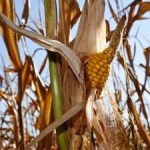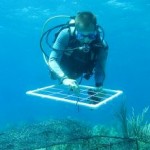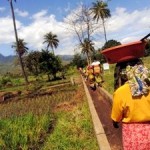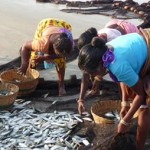The observed precipitation trends are expected to continue in the coming decades. At the same time, Lake Erie’s problems will be compounded by warming lake temperatures, the EcoFore scientists concluded. To explore various phosphorus-runoff scenarios, team members used previously published climate models that project spring precipitation increases in the region of 11 and 29 percent by the end of the century, along with summer temperature increases of 7.2 and 12.6 degrees Fahrenheit.
“Potential impacts of climate change need to be taken into consideration for effective action,” said team member Nathan Bosch of Grace College in Winona Lake, Indiana. “Most indications suggest that climate change will not only exacerbate existing problems but also make reducing phosphorus loads more difficult.”
As Lake Erie warms, its fish will likely feel the squeeze from above and below.
“Climate warming can cause preferred habitat to be squeezed both from above by warmer temperatures and from below via increased hypoxia,” said EcoFore team member Tomas Höök of Purdue University.
In fact, warming water temperatures “may have a stronger effect on fish habitat quality than nutrient loading,” the EcoFore report states. “Under a warmer climate, we may need to reduce (phosphorus) loading levels even more dramatically to have meaningful positive effects on habitat quality and Lake Erie fish stocks.”
The EcoFore team recommends that policymakers set separate targets for reducing both total phosphorus and DRP loading to Lake Erie. A 78 percent reduction in DRP annual load would be needed to reach a Central Basin hypoxia goal of 780 square miles. That’s an area larger than Los Angeles and is roughly the size of the Central Basin dead zone that existed in the early 1990s.
Nutrient-reduction efforts, in the form of agricultural best management practices, should focus on the sites within watersheds that release the most phosphorus into rivers, according to the researchers.
“Importantly, while agricultural BMPs might be less effective under future climates, higher BMP implementation rates could still substantially offset anticipated increases in sediment and nutrient yields,” Bosch said.
The report’s U-M authors are from the Graham Sustainability Institute, School of Natural Resources and Environment, Cooperative Institute for Limnology and Ecosystems Research, Water Center and Department of Civil and Environmental Engineering.
In addition, the study’s 28 authors include researchers at the Ohio Department of Natural Resources, Grace College, Ohio State University, LimnoTech, Purdue University, Heidelberg University, University of Wisconsin-Green Bay, University of Wisconsin-Madison, Korea Environment Institute, NOAA’s Great Lakes Environmental Research Laboratory, the U.S. Geological Survey, Oregon State University, Cardno ENTRIX, and the Carnegie Institution for Science.
Funding for the project was provided by NOAA, the National Science Foundation (NSF) and a Federal Aid in Sport Fish Restoration grant from the U.S. Fish and Wildlife Service and the Ohio Division of Wildlife.
The title of the paper is “Assessing and Addressing the Re-eutrophication of Lake Erie: Central Basin Hypoxia”.
Check the following link to read/download the Full Study:
http://www.sciencedirect.com/science/article/pii/S0380133014000252
Source: University of Michigan.














